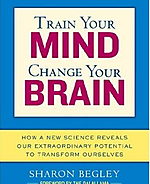The Enchanted Loom
More good newsfrom Train Your Mind, Change Your Brain by Sharon Begley A little over ten years ago now, when I was teaching writing at a drug rehab facility, I remember one of the young men, Rusty, a creative and gifted writer, telling me about a visit he’d had just had with a psychiatrist. The psychiatrist had begun him on a medication (I can’t now remember which one) and the psychiatrist went on to tell him that he was going to have to be on it for the rest of his life. He told Rusty that he’d destroyed a part of his brain with the drugs he’d taken and that the destruction was permanent. This is the first story that came to mind as I was thinking about why a book like Sharon Begley’s book, Train Your Mind, Change Your Brain, might be important. What happens when any one of us begins to think—for whatever reason—drugs, genetics, early traumatic experiences, early deprivation—what happens when we begin to think that our brains are permanently and irrevocably damaged? What kinds of decisions might we make as a result of that model? And what might happen—what different choices might we make—if we were to begin to imagine the brain as an enchanted loom? The metaphor is one first used in 1917 by a British neuroscientist, Charles Sherrington. He described the brain as an enchanted loom, ‘where millions of flashing shuttles weave a dissolving pattern, always a meaningful pattern, though never an abiding one.’ It’s such a fluid metaphor. The brain as a kind of frame—wherein different patterns arise and fall back, constellate and dissolve. Meaningful patterns but not abiding. Not indelible. Not etched in stone. To extend the metaphor some: it used to be thought, and it was taught, that once the frame got built—sometime, say, in early childhood—that was the frame you went through the rest of your life with. And if it got dented along the way, which it inevitably would, then that dented structure is what you were stuck with. The implication also being that a dented structure would be likely to weave a rather misshapen fabric—and even perhaps the same fabric, over and over. Not a particularly encouraging model. Neuroplasticity offers something different. A different model.The loom can change.The actual frame can change.The loom is, well—enchanted. Begley builds a story for neuroplasticity by tracing its early history in Chapter 2 of her book. First, she cites the psychologist William James, who wrote as early as 1890 that ‘organic matter, especially nervous tissue, seems endowed with a very extraordinary degree of plasticity.’ Then she outlines a series of studies, performed by a series of scientists, including the aforementioned Charles Sherrington, who early in the last century began to question whether our brain maps were fixed maps. (Brain maps, first laid out in the late 1800’s, are what they sound like they would be—maps of the brain cortex which lay out which parts of the brain are handling what—including both incoming signals—the sensory signals—and outgoing—or motor—signals. Thus, for instance, a specific portion of your brain receives sensory signals from your fingers when they touch a keyboard. Another portion of your brain is associated with moving those fingers. Yet another section of the brain allows you to process what you see...
read more


